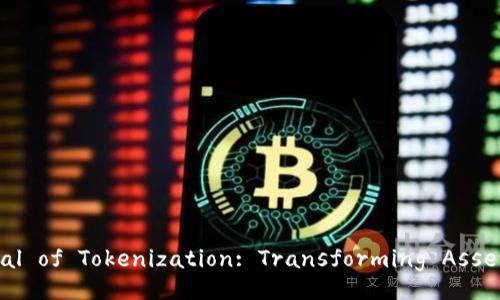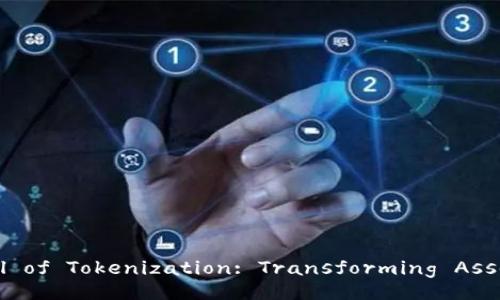Tokenization is revolutionizing the way we view assets in the digital age. The process involves converting ownership rights in an asset into a digital token that resides on a blockchain. This approach not only simplifies transactions but also enhances liquidity, security, and transparency. As traditional assets such as real estate, art, and securities become digitized, tokenization offers new opportunities for investment and participation in various markets.
The rise of blockchain technology has paved the way for tokenization. By leveraging decentralized networks, tokenized assets can be traded peer-to-peer without the need for intermediaries, ultimately reducing costs and transaction times. This methodology has implications for various industries, including finance, real estate, and art, making it a pivotal development in our economy.

Tokenization presents numerous advantages, especially in alleviating some of the common issues associated with traditional asset trading and investment. Here are some key benefits:
One of the most significant advantages that tokenization brings is liquidity. Traditional assets, such as real estate, are often illiquid, meaning they can't easily be sold or exchanged without a substantial time delay. By tokenizing these assets, fractional ownership becomes possible, allowing investors to purchase smaller shares. This fractionalization opens up previously inaccessible markets to a broader range of investors, effectively increasing liquidity.
Tokenization can significantly reduce transaction costs associated with asset sales. In traditional markets, various intermediaries, including brokers and custodians, add layers of fees. Token transactions on a blockchain can streamline these processes, eliminating the need for intermediaries and reducing overall costs. This financial efficiency can translate into better returns for investors.
The blockchain's immutable ledger ensures that all transactions are recorded transparently and securely. This feature minimizes the risk of fraud and enhances confidence among investors. Every transaction involving a tokenized asset is publicly accessible on the blockchain, providing a clear history of ownership and transaction data, which builds trust and facilitates regulatory compliance.
The tokenization process encompasses several critical steps. Understanding these steps can help stakeholders grasp how assets can efficiently transform into blockchain-based tokens.
The first step in tokenization is identifying the asset to be tokenized, which can range from physical assets like real estate to digital assets like stocks and art. Careful consideration should be given to the asset's potential market and regulatory framework.
Legal compliance is paramount in tokenization. Businesses must ensure that the tokenization process adheres to local regulatory requirements and securities laws. This step is crucial for protecting both the issuer and the investors, ensuring that the tokens are legally recognized as securities (if applicable).
Proper valuation of the asset is critical before tokenization. This process typically involves evaluating the asset's market value, utilizing independent appraisals when necessary. The valuation will guide the pricing of the tokens and their fractional ownership representation.
Once the asset has been identified and valued, smart contracts are developed. Smart contracts serve as self-executing agreements written in code. They automatically enforce the terms of the token transactions, handling processes like ownership transfer, payment distribution, and compliance checks.
After the smart contracts have been developed and tested, the final step is the issuance of tokens. These tokens represent ownership shares in the asset and can be sold to investors, creating a new investment vehicle.

While tokenization offers numerous benefits, several challenges must be addressed to enhance its adoption. Understanding these challenges can help both issuers and investors navigate the tokenization landscape effectively.
One of the major hurdles for tokenization is the ambiguity surrounding regulations. Different jurisdictions have varying attitudes toward tokenized assets and cryptocurrencies, leading to confusion for potential issuers and investors alike. Companies must navigate complex legal environments to ensure compliance while simultaneously protecting investors’ rights.
Tokenization relies on sophisticated technology, including blockchain and smart contracts, which may present a barrier for companies unfamiliar with these systems. The lack of technical knowledge or infrastructure could delay execution and create hesitancy among incumbents comfortable with traditional systems.
The concept of tokenization is relatively new, requiring significant education and understanding among both investors and asset owners. There may be skepticism or lack of awareness regarding the effectiveness and safety of tokenized assets. Broader market education is crucial for boosting confidence in tokenization.
While blockchain is inherently secure, vulnerabilities exist, especially concerning the surrounding ecosystem. Hacks, scams, and other forms of cybercrime can pose threats to the security of assets and transactions. Robust security protocols must be implemented to protect against these evolving risks.
The inherent volatility of the cryptocurrency market can also impact tokenized assets, particularly in their early stages. Investors may experience price fluctuations influenced by market sentiment, which can deter investment and complicate valuation efforts.
Tokenization can apply to a variety of assets, including real estate, artwork, stocks, bonds, commodities, and even intellectual property. The key is that any asset with well-defined ownership rights can potentially be tokenized. For example, real estate can be divided into shares, allowing multiple investors to own fractional interests in a property, while artwork can be tokenized to allow for collective ownership and investment.
Different assets may require specific consideration of regulatory compliance and valuation methods. For instance, art pieces may need expert appraisals while real estate might require market comparisons to establish accurate value. The versatility in tokenizable assets makes tokenization an attractive option across numerous industries.
Tokenization enhances liquidity by enabling fractional ownership, which allows investors to buy and sell smaller portions of an asset rather than requiring the purchase of an entire asset. This democratized approach provides access to a wider pool of investors who might not have the capital for full ownership.
Moreover, by implementing trading platforms where these tokens can be traded, the barrier for entry in investment markets lowers. For instance, investors can engage in real estate markets without needing to purchase entire parcels of land but by owning fractions represented as tokens. This drastically improves the liquidity of traditionally illiquid assets.
Smart contracts are self-executing contracts with the terms of the agreement directly written into code and stored on the blockchain. They automatically enforce and execute actions based on predetermined conditions without the need for intermediaries. In the context of tokenization, smart contracts define the rules governing the tokens, such as ownership transfers, payment splits, and compliance checks.
A typical use of smart contracts in tokenization includes transferring ownership from the seller to the buyer once payment is completed. These contracts minimize the chances of disputes and enhance trust in transactions. By eliminating intermediaries, smart contracts allow for faster, cheaper, and more efficient execution of agreements.
The classification of tokenized assets as securities varies by jurisdiction and is subject to the regulations in place. Generally, if a token represents ownership in an asset that yields profit from the efforts of others, it may be deemed a security. However, some jurisdictions have guidelines that separate utility tokens from security tokens, where the former is used primarily to access a product or service rather than for investment purposes.
It's essential for issuers to seek legal advice to ensure compliance with local regulatory frameworks when launching tokenized assets and to understand whether a security offering entails the requirements for registration, disclosures, and investor protections.
Tokenization is poised to transform traditional finance by offering more efficient and accessible methods of transaction. Traditional finance often relies on a series of intermediaries that can slow down transactions and increase costs. Tokenization simplifies these processes by allowing direct peer-to-peer transactions on blockchain networks.
Additionally, the increased transparency and security associated with tokenization can foster greater trust in financial transactions. As tokenized assets gain acceptance, they could lead to the development of new financial products, create more opportunities for fractional ownership, and further enhance market liquidity. Ultimately, the integration of tokenization into the financial ecosystem could drive innovation, streamline processes, and democratize access to investment opportunities.
Tokenization represents a significant advancement in the evolution of asset management and investment. By leveraging blockchain technology and introducing concepts such as fractional ownership, tokenization has the potential to redefine how we interact with various asset classes. While challenges exist, the benefits of tokenization, including increased liquidity, reduced costs, and enhanced transparency, cannot be overlooked.
As society continues to embrace digital transformations, tokenization is expected to play a growing role in shaping the future of finance. Keeping abreast of regulatory changes and technological advancements will be essential for both issuers and investors to fully capitalize on the opportunities tokenization presents. Embracing this innovation can lead to new investment channels, making it an exciting space to watch in the coming years.
leave a reply